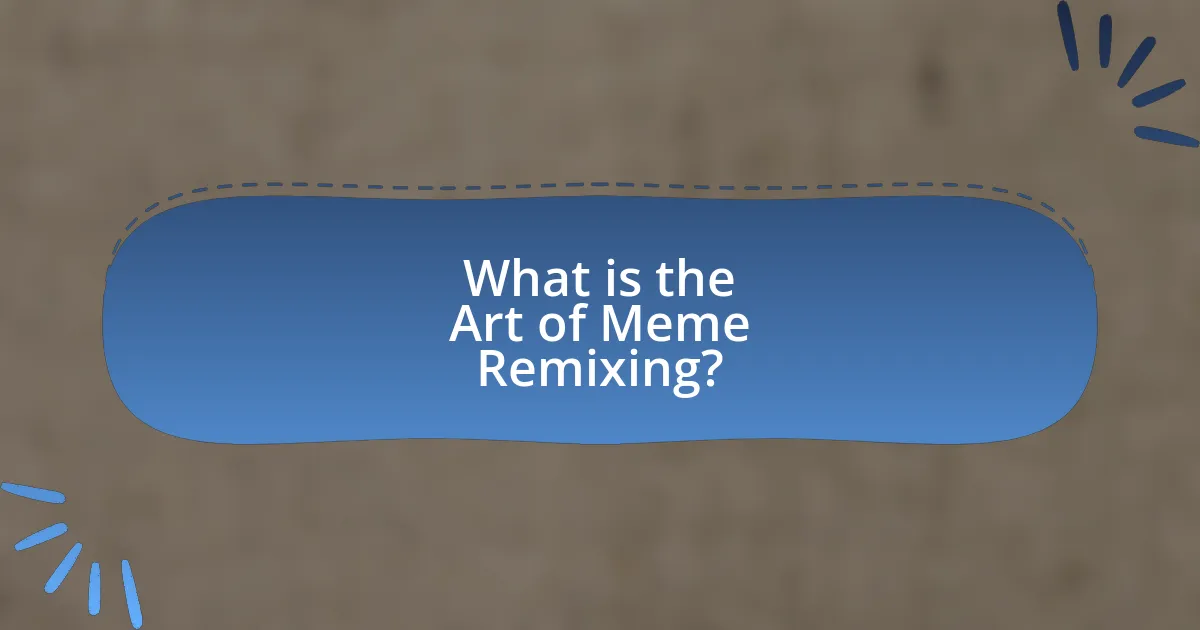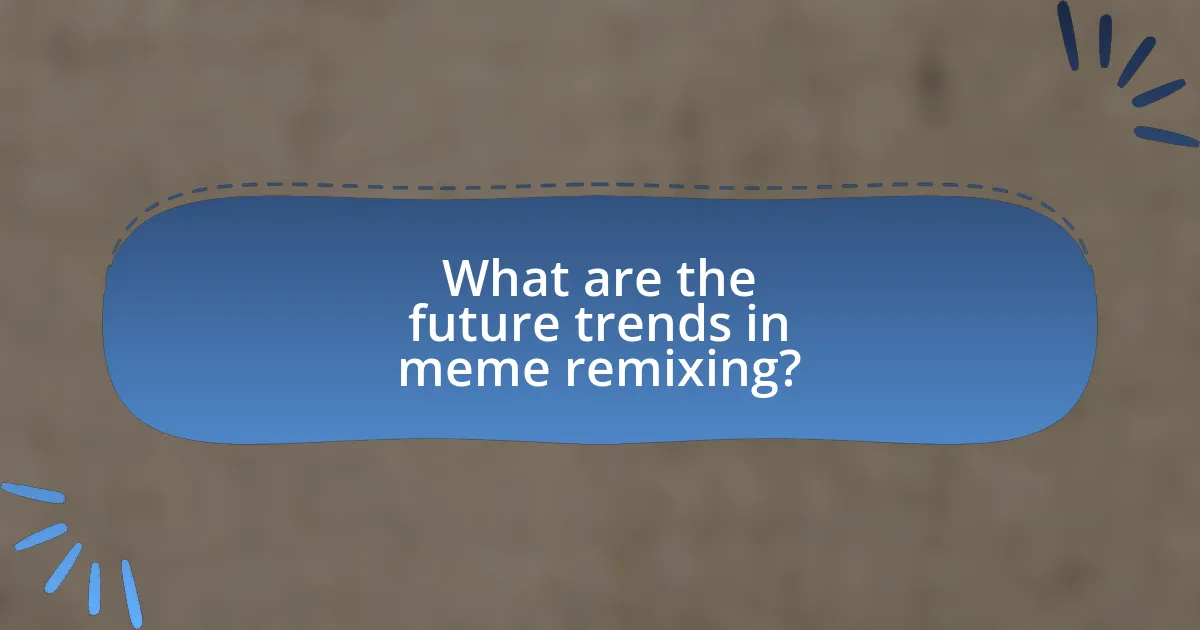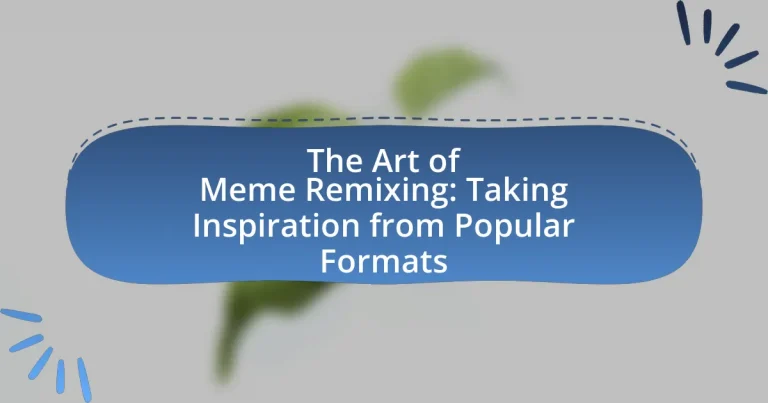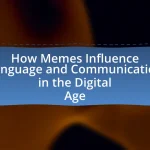The Art of Meme Remixing refers to the creative process of altering existing memes to generate new meanings or humor while maintaining recognizable features of the original. This article explores the differences between meme remixing and traditional meme creation, emphasizing the importance of context, popular formats, and key elements such as relevance, creativity, and shareability. It also discusses the significance of meme remixing in digital culture, its reflection of societal trends, and the ethical considerations involved. Additionally, the article highlights practical techniques for effective meme remixing, the impact of technology and social media on meme dissemination, and future trends in the field.

What is the Art of Meme Remixing?
The Art of Meme Remixing is the creative process of taking existing memes and altering them to produce new meanings or humor. This practice involves modifying elements such as images, text, or context while retaining recognizable features of the original meme, allowing for cultural commentary or personal expression. The effectiveness of meme remixing is supported by its prevalence on social media platforms, where users frequently adapt popular formats to reflect current events or trends, demonstrating its role in digital communication and community engagement.
How does meme remixing differ from traditional meme creation?
Meme remixing differs from traditional meme creation primarily in its reliance on existing memes as foundational elements for new content. While traditional meme creation often involves original ideas or images, meme remixing takes established memes and alters them, adding new contexts, captions, or visual elements to create a derivative work. This process is supported by the concept of intertextuality, where the meaning of the new meme is shaped by its relationship to the original, allowing for layered humor and commentary. For example, the “Distracted Boyfriend” meme has been remixed countless times, with users replacing the characters to comment on various social issues, demonstrating how remixing builds on the cultural significance of the original meme.
What are the key elements of a successful meme remix?
A successful meme remix includes relevance, creativity, and shareability. Relevance ensures that the remix connects with current trends or cultural references, making it relatable to the audience. Creativity involves adding a unique twist or perspective that differentiates the remix from the original, often through humor or satire. Shareability is crucial, as a successful meme remix should evoke emotions or reactions that encourage viewers to share it across social media platforms. These elements collectively enhance the likelihood of the meme remix gaining traction and reaching a wider audience.
Why is context important in meme remixing?
Context is important in meme remixing because it shapes the interpretation and relevance of the meme to its audience. The meaning of a meme can drastically change based on the cultural, social, or situational context in which it is presented. For example, a meme that references a specific event or trend will resonate more with audiences familiar with that context, enhancing its humor or impact. Studies show that memes that align with current events or popular culture are more likely to be shared and understood, as they tap into collective experiences and sentiments. Thus, context not only influences the effectiveness of a meme but also determines its potential for virality and engagement.
What role do popular formats play in meme remixing?
Popular formats serve as foundational templates in meme remixing, enabling creators to efficiently convey humor or commentary. These established structures provide a recognizable context that enhances relatability and engagement, as audiences can quickly grasp the intended message. For instance, the “Distracted Boyfriend” format allows users to juxtapose contrasting ideas, making it easier to express complex sentiments succinctly. This reliance on familiar formats not only streamlines the creative process but also fosters community participation, as users build upon each other’s work, leading to a dynamic exchange of ideas and cultural references.
How can understanding meme formats enhance creativity?
Understanding meme formats enhances creativity by providing a structured framework for expression and innovation. Familiarity with these formats allows individuals to remix existing ideas, leading to novel interpretations and unique content. For instance, the use of popular meme templates can inspire creators to convey complex emotions or social commentary succinctly, as seen in the widespread adaptation of the “Distracted Boyfriend” meme to address various societal issues. This adaptability demonstrates how established formats can serve as a springboard for creative exploration, enabling individuals to engage audiences effectively while maintaining relevance in contemporary discourse.
What are some examples of popular meme formats used in remixing?
Popular meme formats used in remixing include the “Distracted Boyfriend,” “Expanding Brain,” and “Two Buttons” formats. The “Distracted Boyfriend” format depicts a man looking at another woman while his girlfriend looks on disapprovingly, often used to illustrate conflicting choices. The “Expanding Brain” format showcases a series of images representing increasing levels of intelligence or enlightenment, allowing for humorous commentary on various topics. The “Two Buttons” format features a character sweating while deciding between two options, effectively conveying indecision or dilemma. These formats have gained traction due to their versatility and relatability, making them ideal for creative reinterpretation across social media platforms.
Why is meme remixing significant in digital culture?
Meme remixing is significant in digital culture because it fosters creativity and community engagement through the reinterpretation of existing content. This practice allows individuals to express their perspectives, humor, and social commentary by altering popular memes, which enhances cultural dialogue and shared experiences. For instance, the rapid spread of remixed memes during events like the COVID-19 pandemic illustrates how they can serve as a form of collective coping and communication, reflecting societal sentiments and humor in real-time. Additionally, studies show that meme remixing can increase the virality of content, as remixed versions often resonate more with diverse audiences, thereby amplifying their reach and impact.
How does meme remixing reflect societal trends and issues?
Meme remixing reflects societal trends and issues by serving as a digital commentary on cultural, political, and social dynamics. This phenomenon allows individuals to repurpose existing memes to address contemporary topics, such as social justice movements, political events, or public health crises. For instance, during the COVID-19 pandemic, memes were remixed to highlight the absurdities of lockdown measures and the importance of health guidelines, illustrating public sentiment and collective experiences. Additionally, research by the Pew Research Center indicates that 55% of U.S. adults have seen memes related to political issues, showcasing how meme remixing acts as a vehicle for discourse and engagement in societal matters.
What impact does meme remixing have on communication?
Meme remixing significantly enhances communication by facilitating the rapid sharing of ideas and emotions through visual and textual humor. This form of communication allows individuals to convey complex messages succinctly, often using cultural references that resonate with specific audiences. Research indicates that memes can increase engagement and relatability, as they often reflect shared experiences or societal issues, making them effective tools for social commentary. For instance, a study published in the journal “Computers in Human Behavior” by Shifman (2014) highlights how memes serve as a form of participatory culture, enabling users to express their identities and opinions in a relatable manner. Thus, meme remixing not only fosters creativity but also strengthens social connections by creating a shared language among users.
How can one effectively engage in meme remixing?
To effectively engage in meme remixing, one should analyze existing memes for their structure, humor, and cultural references, then creatively alter elements such as text, images, or context to produce a new version that resonates with current trends. This approach leverages the foundational aspects of popular memes, allowing for a fresh take while maintaining recognizable elements that appeal to the audience. Research indicates that remixing is a significant aspect of internet culture, as seen in platforms like Reddit and Instagram, where users frequently adapt and share variations of popular memes, thus fostering community engagement and creativity.
What are the common pitfalls to avoid in meme remixing?
Common pitfalls to avoid in meme remixing include failing to understand the original context, overcomplicating the message, and neglecting audience engagement. Understanding the original context is crucial because memes often rely on specific cultural references; misinterpretation can lead to confusion or loss of humor. Overcomplicating the message dilutes the impact; effective memes are typically straightforward and easily digestible. Lastly, neglecting audience engagement can result in a lack of resonance; successful memes often invite interaction or participation, enhancing their shareability and relevance.

What techniques can enhance meme remixing skills?
Techniques that can enhance meme remixing skills include understanding meme formats, utilizing editing software, and studying viral trends. Familiarity with popular meme formats allows creators to effectively manipulate and adapt existing content, making it relatable to current audiences. Proficiency in editing software, such as Adobe Photoshop or online tools like Canva, enables the seamless integration of text and images, enhancing visual appeal. Additionally, analyzing viral trends on platforms like TikTok or Instagram provides insights into what resonates with viewers, allowing for timely and relevant remixes. These techniques collectively improve the quality and impact of meme remixes.
How can one analyze existing memes for remixing potential?
To analyze existing memes for remixing potential, one should evaluate their visual elements, cultural references, and emotional resonance. Visual elements include the image quality, composition, and recognizable features that can be altered or reused. Cultural references involve understanding the context and significance of the meme within its community, which can inform how it might be adapted. Emotional resonance pertains to the feelings the meme evokes, as memes that elicit strong emotions are often more effective when remixed. For instance, memes like “Distracted Boyfriend” have been widely remixed due to their clear visual narrative and relatable themes, demonstrating their strong remixing potential.
What tools and resources are available for meme creators?
Meme creators have access to various tools and resources that facilitate the creation and sharing of memes. Popular meme-making platforms include Canva, which offers customizable templates and design elements, and Imgflip, known for its meme generator that allows users to add text to images easily. Additionally, GIMP and Adobe Photoshop provide advanced editing capabilities for those seeking more control over their designs. Social media platforms like Instagram and TikTok serve as vital resources for inspiration and distribution, enabling creators to engage with trends and audiences effectively. These tools and platforms collectively enhance the meme creation process, making it accessible and efficient for users.
How can collaboration improve the quality of meme remixes?
Collaboration can significantly enhance the quality of meme remixes by combining diverse creative perspectives and skills. When multiple creators work together, they can share unique ideas, techniques, and cultural references, leading to more innovative and engaging content. For instance, a study by the Pew Research Center found that collaborative projects often yield higher levels of creativity and originality, as participants build on each other’s strengths. This synergy can result in meme remixes that resonate more deeply with audiences, as they reflect a broader range of experiences and humor.
What are the ethical considerations in meme remixing?
Ethical considerations in meme remixing include copyright issues, the potential for misinformation, and the impact on individuals’ reputations. Copyright laws protect original creators, meaning that remixing without permission can infringe on their rights. Additionally, memes can distort facts or context, leading to the spread of misinformation, which can have real-world consequences. Furthermore, memes that involve individuals can harm their reputations or invade their privacy, especially if the content is taken out of context or used in a derogatory manner. These factors highlight the need for responsible and ethical practices in meme creation and sharing.
How can one respect original creators while remixing?
One can respect original creators while remixing by crediting them and adhering to their licensing terms. Crediting involves explicitly mentioning the original creator’s name and linking back to their work, which acknowledges their contribution and fosters a culture of respect. Adhering to licensing terms ensures that the remix aligns with the creator’s permissions, such as using Creative Commons licenses that specify how their work can be altered or shared. This practice not only honors the original creator’s rights but also promotes ethical standards within the remixing community, encouraging a collaborative rather than exploitative approach.
What are the implications of copyright in meme remixing?
Copyright implications in meme remixing primarily revolve around the potential for infringement when original copyrighted material is altered or repurposed. When individuals create memes that incorporate copyrighted images, videos, or text without permission, they risk legal action from the original copyright holders. This is particularly relevant given that many memes utilize recognizable characters or scenes from movies, television shows, or other media, which are protected under copyright law.
The fair use doctrine may provide some protection for meme creators, allowing for limited use of copyrighted material for purposes such as commentary, criticism, or parody. However, the application of fair use is context-dependent and can vary based on factors like the amount of the original work used and the effect on the market value of the original work. Courts have ruled on various cases involving memes, indicating that while some remixing may be permissible, it is not universally protected. For example, the case of “Matt Furie v. Dan McPharlin” highlighted the complexities of copyright in meme culture, where the original creator sought to protect their work from unauthorized use.
Thus, while meme remixing can foster creativity and cultural commentary, it also poses significant legal risks related to copyright infringement.

What are the future trends in meme remixing?
Future trends in meme remixing include increased use of artificial intelligence for content generation, the rise of interactive and participatory memes, and a focus on niche communities for targeted humor. AI tools, such as DALL-E and ChatGPT, are enabling creators to generate unique meme formats rapidly, enhancing creativity and accessibility. Interactive memes, which allow users to engage and contribute, are becoming popular on platforms like TikTok and Instagram, fostering community involvement. Additionally, as social media algorithms prioritize personalized content, meme remixing is shifting towards catering to specific interests and subcultures, making humor more relevant and relatable to diverse audiences.
How is technology shaping the evolution of meme remixing?
Technology is significantly shaping the evolution of meme remixing by providing advanced tools and platforms that facilitate the creation and distribution of memes. Digital editing software, mobile applications, and social media platforms enable users to easily manipulate images, videos, and text, allowing for rapid remixing and sharing. For instance, platforms like TikTok and Instagram offer features that encourage users to create variations of existing content, leading to a dynamic and collaborative meme culture. Additionally, algorithms on these platforms promote viral content, further accelerating the spread and evolution of meme formats. This technological landscape not only enhances creativity but also fosters community engagement, as users remix and respond to each other’s creations in real-time.
What role do social media platforms play in meme dissemination?
Social media platforms serve as primary channels for meme dissemination, enabling rapid sharing and widespread visibility. These platforms facilitate user engagement through features like likes, shares, and comments, which amplify the reach of memes. For instance, a study by the Pew Research Center found that 55% of U.S. adults encounter memes on social media, highlighting their prevalence. Additionally, algorithms on platforms such as Facebook and Twitter prioritize engaging content, further enhancing the likelihood of memes going viral. This interconnectedness allows for the remixing and adaptation of memes, fostering a dynamic culture of creativity and humor.
How might AI influence the future of meme creation and remixing?
AI will significantly influence the future of meme creation and remixing by automating content generation and enhancing personalization. Advanced algorithms can analyze trending topics and user preferences, allowing for the rapid production of relevant memes that resonate with specific audiences. For instance, AI tools like DALL-E and GPT-3 can generate images and text based on user prompts, enabling creators to produce unique and contextually appropriate memes quickly. Additionally, AI can facilitate the remixing process by identifying popular meme formats and suggesting variations, thus streamlining the creative workflow. This capability is supported by the increasing use of machine learning in digital content creation, which has shown to improve engagement rates by tailoring content to audience interests.
What practical tips can improve your meme remixing efforts?
To improve your meme remixing efforts, focus on understanding current trends and utilizing popular formats effectively. Analyzing trending memes allows you to identify elements that resonate with audiences, such as humor, relatability, or cultural references. Additionally, using meme templates from platforms like Know Your Meme or Imgflip can streamline the creation process, ensuring your remixes maintain visual appeal and context. Engaging with online communities on social media platforms can provide feedback and inspiration, enhancing your creative output. Research indicates that memes that align with audience sentiments and cultural moments tend to achieve higher engagement rates, reinforcing the importance of staying relevant in your remixing efforts.


